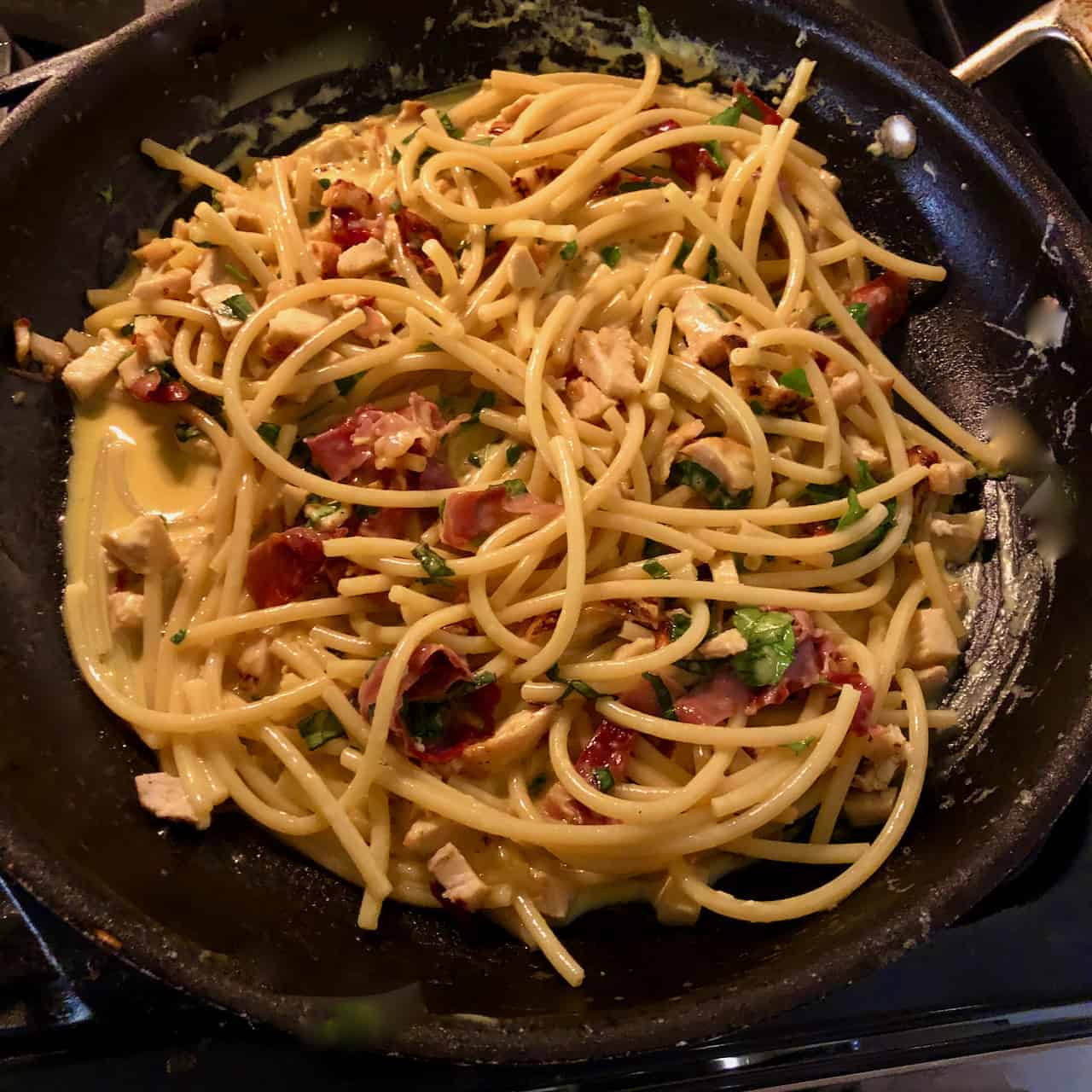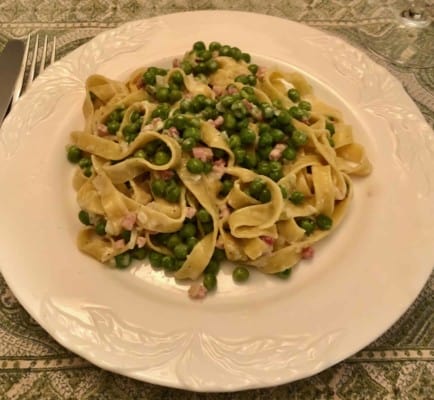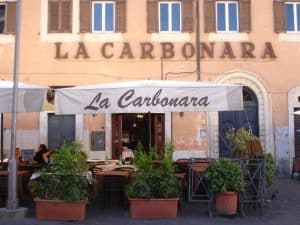
Rome’s favorite and most famous pasta dish gets a major makeover.

When I lived in Rome, I can’t count how often I would order this dish. At least once a week, I would sit down to a bowl of this pasta. Just four ingredients made up this decadent dish. Eggs, eggs, hard cheese, pancetta, pepper, and pasta. That is, in the classic Roman recipe. Here, Giada De Laurentiis, of Food Network fame, has added cream, basil, parsley, garlic, and even some chicken making this thoroughly American. No Italian would mess with this classic. But the result was a huge pleasure to eat. The recipe takes just 42 minutes from start to finish. The Italian-born Giada Pamela De Benedetti was born in Rome. Her maternal grandfather was famed film producer Dino De Laurentiis. After her parent’s divorce, Giada and her 3 siblings moved to Los Angeles and changed their name to match their grandfather’s. Little known fact: her grandmother was British-Italian film star, Silvana Mangano.
Where did Carbonara come from? The ingredients actually have American roots.
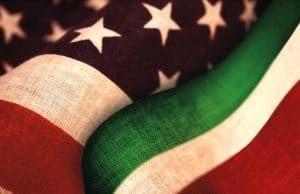
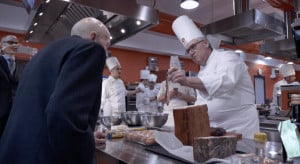
Carbonara is not one of those Italian dishes with a lengthy past. In fact, the earliest recipes for the dish didn’t appear in Italy until the 1940s. Its creator was a Chef named Renato Gualandi. Born in Emilia Romagna in 1921, Gualandi started work as a delivery boy for Bologna’s best-known butchers. By the end of the Second World War, Renato was cooking in Riccione, a seaside town on the Mediterranean coast. When the town was liberated by the Allies, Gualandi was put in charge of a banquet celebrating this victory. The guests included Harold MacMillan, who thirteen years later would become Prime Minister of Britain. Gualandi’s task was not made easy. Rationing was still in effect. Gualandi wanted to create a dish that brought together Italian and Anglo-Saxon cuisine. The sauce he concocted would be made from American bacon, cream, processed cheese, and dried egg yolk. It was an immediate success. If I may be so bold, I think today’s recipe is a great advance on processed cheese and dried egg yolk.
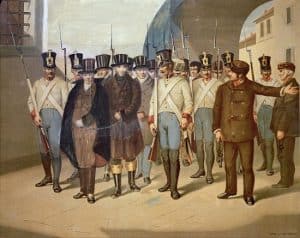
Why is it called Carbonara? Unfortunately, we cannot ask Renato Gualandi.
By all accounts, Chef Gualandi lived a charmed life. He died at age 95 in 2016. Until the last, he kept up with his favorite pastimes: minding his vegetable and herb gardens, entertaining and cooking at his home in the hills of Rimini. “Alla Carbonara” translates to “In the style of the coal workers”. But given its origins, that’s a stretch. More credible is that Gualandi named it for the Carbonari, a secret society that worked underground to create a liberal, unified Italy. At an International banquet, was this his way of saluting his country’s liberation?
The one ingredient that’s vague is what type of pasta to use with Carbonara.
Most Italian pasta dishes are assigned a specific pasta shape. But in Pasta Carbonara, any type of pasta will do. Spaghetti is typical but fettucini, rigatoni, linguine, and the bucatini we used, are all very common in Carbonara recipes. While Giada used pancetta, Gualandi’s bacon lardons and guanciale are also commonly used. Here we used Prosciutto, another kind of pork that we happened to have a lot of on hand. Like Giada, we used Parmesan cheese and not the traditional Pecorino Romano. Our pasta of choice was Bucatini. And instead of the shredded rotisserie chicken, we used already grilled chicken. It added a little smoky flavor that added a soupçon of flavor of its own. The other major change we made was to take the cream sauce off the heat, then add the bucatini and chicken and toss the mixture. This avoided ‘scrambling’ the eggs and gave us the most creamy, luscious Carbonara sauce we enjoyed immensely. Here is the recipe. After it, some other pasta recipes you will enjoy.
pasta will do. Spaghetti is typical but fettucini, rigatoni, linguine, and the bucatini we used, are all very common in Carbonara recipes. While Giada used pancetta, Gualandi’s bacon lardons and guanciale are also commonly used. Here we used Prosciutto, another kind of pork that we happened to have a lot of on hand. Like Giada, we used Parmesan cheese and not the traditional Pecorino Romano. Our pasta of choice was Bucatini. And instead of the shredded rotisserie chicken, we used already grilled chicken. It added a little smoky flavor that added a soupçon of flavor of its own. The other major change we made was to take the cream sauce off the heat, then add the bucatini and chicken and toss the mixture. This avoided ‘scrambling’ the eggs and gave us the most creamy, luscious Carbonara sauce we enjoyed immensely. Here is the recipe. After it, some other pasta recipes you will enjoy.
Chicken Carbonara
An Italian American take on Rome's favorite pasta made even more substantial than the classic recipe and creamier than ever before.

Ingredients
- 2 teaspoons olive oil
- 4 ounces thinly sliced pancetta, chopped
- 2 teaspoons minced garlic
- 2 1/2 cups whipping cream
- 1 cup freshly grated Parmesan
- 8 large egg yolks
- 1/4 cup chopped fresh basil leaves
- 1/4 cup chopped fresh Italian parsley leaves
- Salt
- 1 pound spaghetti or any pasta of your choice
- 4 cups coarsely shredded chicken (from 1 roasted chicken)
- Freshly ground black pepper
- 1/2 cup chopped walnuts, toasted
- 1 tablespoon finely grated lemon peel
Directions
- Step 1 Heat the oil in a heavy large frying pan over medium heat. Add the pancetta and garlic and saute until it is brown and crisp about 8 minutes. Cool slightly.
- Step 2 In a large bowl, whisk together the cream, cheese, yolks, basil, and parsley to blend.
- Step 3 Meanwhile, bring a large pot of salted water to a boil over high heat. Add the spaghetti and cook until it is just tender but still firm to the bite, stirring occasionally for about 10 minutes. Drain.
- Step 4 Add the chicken to the pan with the pancetta and stir to combine. Next, add the spaghetti and the cream mixture and toss until the chicken is heated through and the sauce coats the spaghetti thickly. Season the pasta, to taste, with pepper and salt if needed (the pancetta will likely add all the salt you need). Transfer the pasta to a large wide serving bowl. Sprinkle the walnuts and lemon zest over, and serve.
Food and Wine’s Best Recipe of 2002: Pasta with Sausage Basil and Mustard from Nigel Slater
